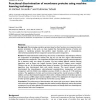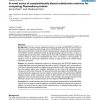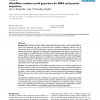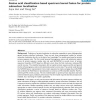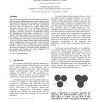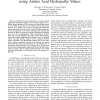BMCBI
2008
14 years 28 days ago
2008
Background: Discriminating membrane proteins based on their functions is an important task in genome annotation. In this work, we have analyzed the characteristic features of amin...
BMCBI
2007
14 years 28 days ago
2007
Background: In an epitope-based vaccine setting, the use of conserved epitopes would be expected to provide broader protection across multiple strains, or even species, than epito...
BMCBI
2008
14 years 28 days ago
2008
Background: The most common substitution matrices currently used (BLOSUM and PAM) are based on protein sequences with average amino acid distributions, thus they do not represent ...
BMCBI
2007
14 years 28 days ago
2007
Background: Detection of short, subtle conserved motif regions within a set of related DNA or amino acid sequences can lead to discoveries about important regulatory domains such ...
BMCBI
2010
14 years 28 days ago
2010
Background: Prediction of protein localization in subnuclear organelles is more challenging than general protein subcelluar localization. There are only three computational models...
ISMB
1993
14 years 2 months ago
1993
Using a flexible representation of biological sequences, we have performed a comparative analysis of 1208 known tRNA sequences. We believe we our technique is a more sensitive met...
APBC
2003
14 years 2 months ago
2003
The interactions of large molecules with surfaces and with each other are strongly dependent upon their surface, rather than their bulk properties. In addition, the local properti...
DASFAA
2005
IEEE
14 years 6 months ago
2005
IEEE
A novel approach for similarity search on the protein structure databases is proposed. PADS (Protein Alignment by Directional shape Signatures) incorporates the three dimensional ...
CIBCB
2005
IEEE
14 years 6 months ago
2005
IEEE
— Proteins have been discovered to contain ordered regions and disordered regions, where ordered regions have a defined three-dimensional (3D) structure and disordered regions d...
ICASSP
2007
IEEE
14 years 7 months ago
2007
IEEE
Protein structure prediction aims to determine the three-dimensional structure of proteins form their amino acid sequences. When a protein does not have similarity (homology) to a...
